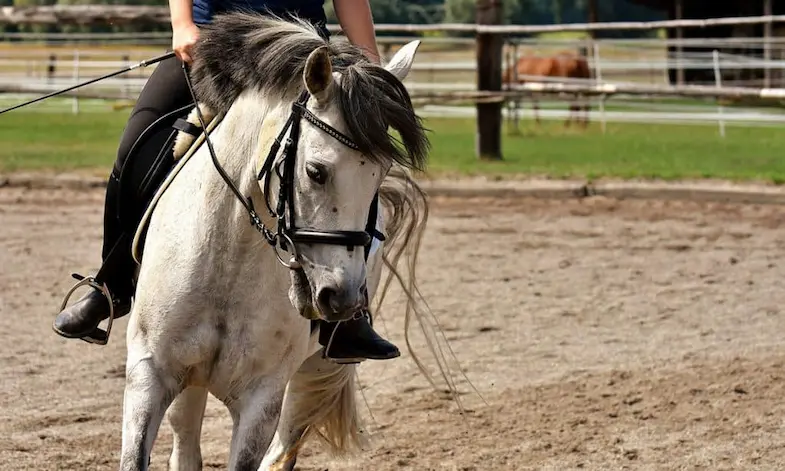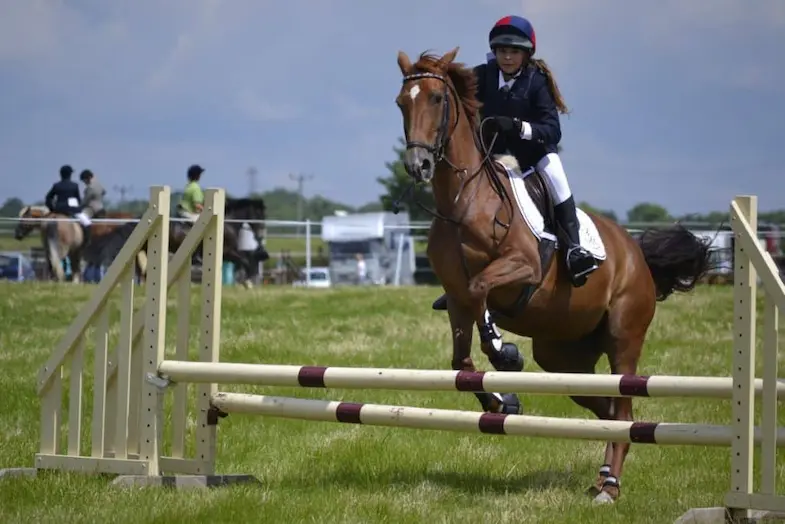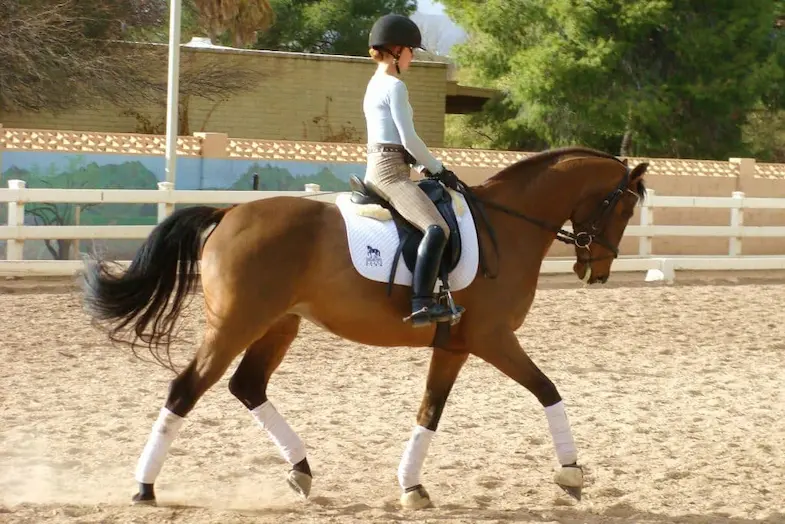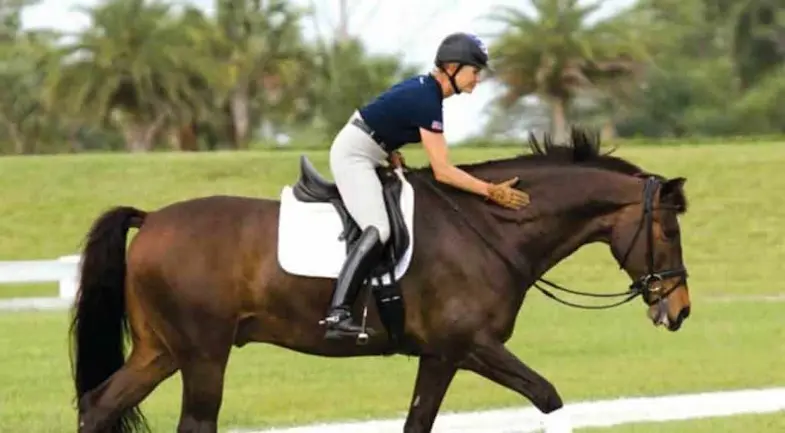We all strive to be better riders, but what is it that makes the difference between a good rider and a great one? You might be surprised to know there are a few things that set the greats apart from the rest of us but the good news is that being a great rider is within everybody’s grasp, regardless of their discipline.
You might think that the most obvious thing that will help you improve is to practice, and yes there is a certain amount of this, but for most people, this just isn’t an option so how do you become a great rider without practicing? Okay so that’s a little bit misleading, of course, you do need to practice but, if you do things right, you can achieve this with as little as just a few hours riding a week.
Decide what you want to achieve
Even if your ultimate goal is to be a better rider it’s still a good idea to think about what it actually is you want to do. What does being a better rider mean to you? Do you have a particular objective you want to meet? For example, do you want to set a new personal best, do you want to try a new discipline, or do you simply want to enjoy the time you spend with your horse more?
As well as deciding what you want to achieve it’s also helpful to have a realistic timeframe in mind. After all, if you’ve been out of the saddle, or if your horse has been rested, for a few years then no matter how much you want to you’re not going to be competition-ready within a month. Setting a timeframe will help you to pace both yourself and your horse while also, hopefully, help you to realize that you can easily achieve your goal.
Create a plan
Where to start? Whatever I’m doing, regardless of whether it involves horses or not, I always find that it’s incredibly helpful to create a written plan. I know that may sound dumb and that you’re probably thinking ‘but I know where I want to get, why do I need to write it down?’ but believe me it really helps to do this, especially when you have a setback further down the line and think you’ve not achieved anything. Going back and looking at this plan will not only help to show you how far you’ve come but will also help to keep you on track.
What should my riding plan look like?
It’s up to you how detailed you make your plan but what is important is that you take your final goal and then break it down into small steps. Let’s say, for example, that being a better rider to you means that you can set your fastest ever clear round in the showjumping ring. If that’s your goal then your plan may look something like this:
- Make sure your horse is fit and has good muscle strength – if he has a weak back then this article will help you.
- Make sure you are fit
- Start incorporating pole work into your ride
- Jump clear over 1.6ft (0.5 meters)
- Clear the round faster
- Jump clear over 3.2ft (1 meter)
- And so on until you reach the height and time you want.
As you can see there doesn’t need to be a lot of detail, just enough to give you a few pointers along the way.
Believe in yourself
Be honest, how often have you heard this and thought ‘yeah right, that won’t make any difference’? Yet when it comes to riding, believe it or not, it can make a real (and big) difference.
Not believing in yourself will have a negative effect on your riding for two reasons:
You’re holding yourself back – If you’re constantly thinking about a mistake you made the other day, or that you’re just not good enough to do it you’re actually telling yourself you can’t. You might not even be aware of it but thinking negatively will not only stop you from trying but also from improving. It’s not easy but if you can put any negative thoughts out of your mind (even if only just when you ride) it will help. Instead of thinking about where you did something wrong think about why you did it wrong, how can you not do that again, and what you did right.
You might feel silly doing it but before you get on your horse say to yourself ‘I will be the best rider I can be today’. Nobody’s perfect and accepting that you’re not will help you to improve because you’ll understand it doesn’t matter if you make a mistake, as long as you tried – you’ll succeed next time.
Horses are sensitive animals – While your horse won’t understand exactly what you’re thinking and how you’re feeling he will know that something is wrong. How he deals with this will largely be down to his personality but he will most likely take this as an indication that something is wrong or there’s something to be frightened of. If he feels that there’s a good reason for him to be nervous then he won’t be relaxed either, you’ll, therefore, have to deal with his nerves as well as your negativity. If, however, on the other hand, you’re thinking positively he’ll be more willing to cooperate.
Don’t be afraid to have a trainer
You may have been riding since before you could walk but it’s all too easy to get set in your ways and get into bad habits. Part of the battle to achieving anything is admitting that you don’t know everything and that you can always learn.
Seeking the help of a trainer isn’t a sign of weakness but a sign of strength, after all, it takes courage to admit you need to improve. It’s the job of a trainer to not only help you realize your goals but also become a better all-round rider. They will work with you to help you focus on the areas where you need to improve the most.
Trainers can be expensive and not everybody can afford to pay for lessons every week so don’t worry if this is the case, if your trainer is any good then they’ll understand that and will work with you to formulate a plan where you can still achieve what you want to but with fewer lessons from them. Even one lesson a month is better than not having any at all.
Online training
Most of us have a fast enough internet connection these days to be able to take advantage of websites such as Equestrian Coach, they provide helpful training videos to help you improve your riding, get more out of the time you spend with your horse, or simply help fix problems you may have. They even have videos from some of the best Olympic and World-Class coaches around, and best of all, for a limited time if you use the code HORSEFACTBOOK you can get 10% off.
Have a role model
Role models aren’t just for kids growing up who want to be pop stars or footballers they’re for everybody. Who do you look up to most in the equestrian world and why? It doesn’t have to be somebody famous but we all have somebody we look at and think ‘I wish I was more like them’ or ‘how do I get to be like that’. What is it you admire about that person, why do you want to be more like them? Try to find out how they approach things or what it is that they do. If you know the person then simply ask them, chances are they’ll be flattered and more than happy to help you. If, however, they’re famous then don’t worry you can still find out – it’ll just take a little bit more work. Most famous riders have given an interview or two about their career and their training regimen and these days the vast majority of these interviews will be online so simply search for any they’ve done.
How to improve your seat
Having a good seat is probably the most crucial aspect of riding to get right, not just for your benefit but for that of your horse too, but it’s easy to just say you need to improve your seat, what’s more, important is how do you do it?
At some point, we’ve all been told to hold a cup of water with our arms outstretched in order to help improve our balance and while this does help, of course, there’s more to having a good seat than just balance. With a good seat, you’re sitting deep into the saddle, are completely upright but are also relaxed. Having a good seat will also allow you to ride the horse with your body and not just your legs.
The key to having a good seat is to be relaxed in the right places. You need to keep your back straight, your shoulders back, and your head up. Keeping your head up is so important because you’re not only looking where you’re going but you’re also keeping your center of gravity in the best place for your horse. Some people say that if you tilt your head just 15 degrees then you’re increasing the weight the horse has to carry by around 15lbs. While there’s no evidence to prove or disprove this there is plenty of evidence to show that sitting with your head tilted will make it harder for the horse to be balanced.
To improve your seat ask somebody to hold your horse then follow these simple steps:
- Sit as tall as you can, with your head up and your eyes looking straight forward.
- Next, keep your head and back where they are but bring your shoulders up as high as you can.
- Take deep breaths while holding your shoulders up and count to ten slowly.
- Now begin to gently relax your shoulders, maintaining your posture as you do so.
- Before you begin your ride make sure that both you and your breathing are relaxed.
How to be a more confident rider
Part of the challenge of being a better rider is to be more confident but as we all know it’s not as easy as just saying you need to be more positive. Even the most confident person in the world will have self-doubt and be critical of themselves and of their ability from time to time. This is normal but the good news is there are things you can do to help make you a more confident rider.
But why is it important to be confident when you ride? Right from the first time we get in the saddle, we’re taught that horses can sense how we feel and that the more relaxed and confident we are the more they will be and the better ride we’ll have.
Let the horse move
You don’t need to, nor should you, completely let go of the reins and let your horse do what he wants to and go where he wants to. What I really mean is allow your horse time to find his stride and balance. Every horse has their own stride and if you’re constantly trying to hold him back or forcing him to go at a certain pace he can’t find that stride. If you give him time to find that and then go with the flow you’ll be surprised at just how little effort you both use, you’ll probably also find that it’s a lot more comfortable.
If you can allow your horse to do this then you’ll find it liberating which will help to improve your confidence as a rider.
Trust your horse
Just as we do, horses will trip from time to time without any reason. Don’t worry about it and certainly don’t try to pull your horse out of a misstep or trip. Instead, allow him to find his footing again and just go with the flow of it.
I know that sometimes it’s not easy to just ‘go with the flow’ but providing your horse doesn’t fall completely and you have a good seat then you should be able to ride through this and then carry on as before.
This will have a two-fold effect of not only improving your riding position and balance but also of improving your horse’s confidence too.
Be patient
If something is worth doing it’s worth doing properly so don’t cut corners by trying to do everything in a weekend. The key to changing things and improving is to take little ‘baby’ steps.
When you’re asking your horse to do something he doesn’t understand don’t get cross with him but instead, help him to understand what you’re asking him to do and take your time. If you need to, show him what to do or lead him through it. The calmer you are with him the more willing he’ll be.
Always finish on a good note
It’s human nature to remember bad things more than good things so its important to make sure you finish every ride or training session on a good note, even if that means that you don’t have a full lesson or your lesson is extended.
We’ll all have lessons where we feel that nothing is going right at all, don’t feel disheartened by this, nothing that’s worth doing in life is easy so instead go back to what worked last time and refine that. Don’t keep forcing things if it’s just not happening, you might feel as if you’re taking a step backward but believe me if you do this your next lesson will be a million times better!
Sit tall and keep your body open
If you’ve heard it once you’ve heard it a million times but sitting tall in the saddle not only helps you to maintain your balance but it also helps you to literally ride better. Sitting with your spine straight and your shoulders back means that you can not only move in time with your horse but that your ‘open body’ posture will give you (and your horse) more confidence.
Breathe
This is another one of those things that we’ve all lost count of how many times we’ve been told to do! Yet despite being the most important thing to our survival it’s amazing how many times we ‘forget’ to just breathe. We’ve all been there before, you’ve in the middle of a lesson and you’re concentrating so hard on getting everything right when you suddenly realize you’re feeling a bit little headed! Not breathing obviously isn’t good for your health but you might be surprised to know that it can cause you to become tense and that this tension can have an adverse effect on your riding.
A good tip is to try and breathe in time to your horse’s movements, it can take a bit of practice to do at first and some people find it helpful to count out loud but it’s definitely worth doing. It will also help to make you more relaxed.
How to get back on after a fall
Falling off, unfortunately, is part of riding and while we’re always told to get back on straight away this isn’t always easy or even possible sometimes, so what should you do if your confidence has taken a knock and you’re nervous about getting back on?
- Understand why you fell in the first place – Is there anything you could have done to prevent it?
- Speak to your instructor – If you don’t have an instructor it wouldn’t hurt to have a few lessons to help you regain some of your confidence.
- Ride a ‘safe’ horse – If your horse is lively then riding a quieter horse to start with will help to build your confidence back up.
- Don’t put pressure on yourself – Ever rider out there has fallen off at some point so don’t start putting pressure on yourself by giving in to the thought that you can’t be a good rider.
- Invest in a body protector – While it won’t prevent you from falling it will help to minimize any injuries you might sustain. A riding helmet is also a good idea, you might want to read this article I wrote about the importance of wearing a riding helmet.
- Remember that despite your fall you’re still able to ride.
Further reading
If you found this article helpful then you might find these interesting:
- Do horses like being ridden
- Horse riding with back pain
- Am I too old to learn to ride?
- Can I ride while pregnant?
- Is horse riding good for losing weight?
- Best breeds for new riders
- Best breeds for trail riding
- How horses help with autism
- Exercises for horses with weak backs
- Is horse riding vegan?
I hope you found this article helpful. If you did I’d be grateful if you could share it please as it would really help me.
Recommended products
Over the years I have tried hundreds of different horsey products, from various blankets and halters to different treats. Some I’ve loved, others I’ve hated but I thought I’d share with you my top all-time favorite products, the ones I never leave the yard without. I’ve included links to the products (which are in no particular order) that I really think are great.
- Horse Knots by Reference Ready – If you’re like me and enjoy pocket reference guides then you’ll love this knot tying guide. These handy cards can easily fit in your pocket or attach to the saddle for quick reference. They’re waterproof, durable and are color coded to make them easy to follow.
- Mane ’n Tail Detangler – Even if you never show your horse you’ll need to detangle his tail from time to time (and possibly his mane too) which is always a challenging chore! I’ve found that if I run a little bit of detangler through my horse’s tails every few days it stops them from getting matted up and makes combing them easy, even if they’re coated in mud. I don’t know if I should admit to this or not but it also works wonders on my hair.
- TAKEKIT Pro clippers – Over the years I’ve tried a lot of different clippers and while some were obviously better than others I found these to be by far the best. They are heavier than a lot of other clippers but for me, that’s a good thing, it makes them feel more sturdy and hardwearing. On top of that they have a range of speeds so are just as good for clipping your horse’s back as they are his face. I also like the fact that they come in a handy carry case but that’s not for everybody. The company that makes them is super good and incredibly helpful too, a real bonus these days. The only thing I wasn’t keen on was the fact that it doesn’t come with any oil, but that’s not a major problem as it’s not difficult to buy lubricant.
- Shire’s ball feeder – There are so many boredom buster toys out there but I like to use these every day, regardless of whether or not my horses are bored. I find that it helps to encourage my horses to problem solve by rewarding them with treats (or pieces of fruit) but it also mimics their natural grazing behavior which helps to keep them calm and de-stressed.
- Horse safe mirror – This is a strange one that many people are surprised about but I like to put horse safe mirrors in the trailers as well as in the quarantine stalls. It helps to prevent the feeling of isolation by giving the impression of other horses being around. Being herd animals horses can get extremely stressed when they feel that they’re on their own but with these stick-on mirrors, they believe that at least one other horse is with them.
- Rectal thermometer – I know this isn’t glamourous at all but it’s vital for your horse’s well-being to be able to check their temperature and a rectal thermometer is the easiest way of doing this which is why I’ve added it to the list.
Shopping lists
I’ve also put together a few shopping lists of essential items that I’ve found helpful over the years. I’ve broken the lists down into different categories rather than put everything in one massive list 😉





